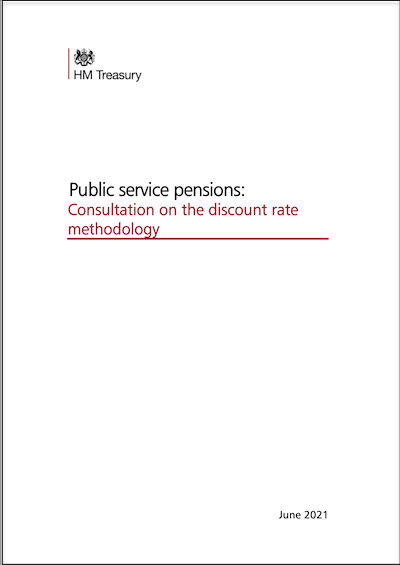
The government is looking at redefining the methodology for contributions to unfunded pensions schemes. Barry McKay considers the implications.
There was a significant increase in employer contributions for the unfunded public sector schemes following the last round of actuarial valuations. This was in part down to a lower discount rate being used to carry out the calculations. The discount rate used for these valuations is the Superannuation Contributions Adjusted for Past Experience discount rate, or given that doesn’t roll off the tongue very easily, the SCAPE rate.
The government has recently issued a consultation on the methodology that is used to set this.
16 November 2021
London Stock Exchange or ONLINE
Room 151’s LGPS Investment Forum
Our annual gathering of administering authorities of the LGPS, their investment pools and advisers.
Qualifying local government investment officers can register here.
Objectives
The consultation considers the SCAPE rate methodology only, not the actual level of the SCAPE rate.
The last consultation in December 2010, saw a change in methodology from the Social Time Preference Rate (STPR)—which is based on the rationale that people prefer to have things now— to a methodology based on expected long-term UK GDP growth. The methodology has to be reviewed every 10 years.
Even though use of the SCAPE rate is primarily for setting employer contributions for unfunded public sector schemes, the objectives are effectively the same as for a funded pension scheme, namely:
- Affordability. The cost of benefits accrued today will be met from future revenue so they need to be affordable;
- Stability. Employers prefer cost stability to help with decision-making and budget setting;
- Intergenerational fairness. An appropriate current level of contributions is set to pay for the benefits being accrued today.
As with any pension scheme valuation this is a tricky balancing act as these objectives are often conflicting.
Impact
Apart from the pledge to review the methodology, there are a few reasons for the review:
- The SCAPE rate has been decreasing over time. It was originally set at CPI+3% and is currently CPI+2.4%. This lower rate increases employer costs, possibly significantly;
- The OBR (Office for Budget Responsibility) forecast expectations for GDP are even lower than CPI+2.4%, in the short to medium term, so the SCAPE rate could be reduced further giving the government and employers a bigger headache;
- Estimates of GDP growth can change from one year to the next and this is not reflected in the long-term average SCAPE rate.
So, the main impact is a potential further increase to employer contributions in the unfunded schemes if the SCAPE rate was reduced ahead of the next round of valuations with higher contribution rates effective from April 2024.
Employees could also be indirectly affected as the SCAPE rate may be used to determine actuarial factors that apply to early and late retirement pensions for example, feeding into member benefits, but also through the impact on employers’ budgets.
Other impacts
One other aspect to consider is the potential future link between the SCAPE rate and the cost control mechanism (CCM).
The cost control mechanism, designed to ensure the cost of the public sector pension schemes remains within an agreed target cost, is also under proposed reforms in a separate consultation.
One of the proposals is to add an economic check into the CCM to ensure that any benefit changes required would be consistent with the expected long-term economic outlook.
This would help avoid the current LGPS scenario where the current mechanism implies the cost of the LGPS has reduced as a result of a slowing down of future life expectancy improvements and lower salary growth. However, the cost of funding future benefits accruing has actually increased due to falling discount rates.
If the SCAPE rate or the methodology changes this could have an impact on the economic check, the CCM and ultimately any potential proposed changes to members’ benefits.
Rightly or wrongly, the SCAPE rate is also used in carrying out some aspects of the Section 13 LGPS valuations and although contribution rates are set using a local funding discount rate, funds tend to have an eye on the SCAPE discount rate so as not to fall foul of Section 13 tests.
Therefore, any changes could also indirectly impact the discount rate adopted for LGPS funding valuations and employer contribution rates.
Options
The options as set out in the consultation are to either stick with methodology based on long-term GDP growth or switch back to the STPR methodology, both with some possible modifications.
With long-term GDP growth, the methodology could allow for term-dependent GDP growth and/or actual GDP experience. Term-dependent GDP growth could result in fairer costs but might not help with the stability objective.
Actual GDP growth could also help with fairer costs but as actual experience has been lower than expected for a number of years now, adopting this approach would likely increase contributions and not achieve the objective of affordability or, initially at least, stability.
The STPR methodology would result in a higher discount rate as this is currently CPI+3.5% so would meet the affordability objective but probably not fairness of costs.
Possible modifications to make this methodology more appropriate for a pension’s context would reduce the rate to below CPI+2.5%, so similar to the current long-term GDP approach. This might achieve the stability and affordability objective but possibly not fairer costs as there is less of a link to future Government income and so may result in changes in the longer term.
Schemes like the LGPS, hold assets and have benefitted from strong market returns for the last decade. Whatever methodology is adopted, given recent levels of, and the outlook for, future economic growth, the bigger questions are whether future revenues will be enough to pay all the benefits building up for around six million members, whether unfunded schemes are affordable and sustainable in the long term and whether decisions such as these should be made by an independent pension committee to remove the political angles. One for another day, possibly.
Barry McKay is a partner at actuaries Barnett Waddingham.
Photo by Jeswin Thomas on Unsplash
—————
FREE monthly newsletters
Subscribe to Room151 Newsletters
Room151 Linkedin Community
Join here
Monthly Online Treasury Briefing
Sign up here with a .gov.uk email address
Room151 Webinars
Visit the Room151 channel













